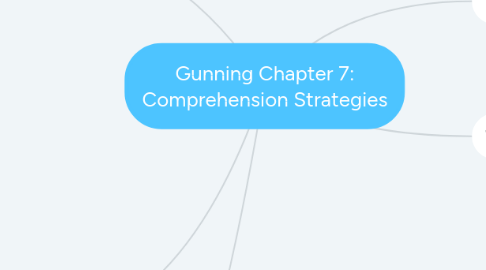
1. Teaching Organizational Strategies
1.1. Comprehending the main idea
1.1.1. Provides framework for organizing, understanding, and remembering key details.
1.1.1.1. Classifying
1.1.1.1.1. Ex: Sorting
1.1.1.2. Reading topic sentence
1.1.1.2.1. Helps to comprehend the main idea
1.2. Selecting or constructing the main idea
1.2.1. Step1: Use heading, title, etc. to make a hypothesis about the main idea; Step 2: read each sentence; Step 3: If the student can't form a hypothesis, have them identify what all sentences have in common; Step 4: Make or select a sentence that explains what all of the other sentences are about.
1.3. Extending the ability to create the main idea
1.4. Determining relative importance of information
1.4.1. Sequencing
1.4.2. Summarizing Information
1.4.3. Following Directions
2. Teaching Elaboration Strategies
2.1. Making inferences
2.1.1. Most important
2.1.1.1. "It says - I say - And so" chart
2.2. Using QAR
2.2.1. Question-Answer Relationship
2.3. Applying the skill
2.3.1. Applied in discussions when reading into the content areas
2.4. Macro-cloze
2.4.1. Students use their background of experience and inferential reasoning to supply a missing sentence.
2.5. Mystery passages
2.5.1. Can assess comprehension
2.6. Imaging
2.6.1. Serves 3 functions
2.6.1.1. Fosters understanding
2.6.1.2. Helps to retain information
2.6.1.3. Provides monitoring for meaning
2.6.2. Dual-coding
2.6.2.1. Verbal / Non-verbal
2.7. Manipulatives
2.7.1. Readers can understand an action by applying those actions specified in text
2.8. Question Generation
2.8.1. Turns passive readers into active participants
2.8.1.1. Ex: ReQuest (reciprocal questioning)
3. Teaching Monitoring (Metacognitive) Strategies
3.1. Helps students know oneself as learners
3.2. Regulating
3.3. Checking
3.4. Repairing
3.4.1. using references
3.4.2. using text aids
3.4.3. slow reading rate
3.4.4. paraphrasing
3.4.5. pausing
3.4.6. read aloud
3.4.7. lookback
3.4.8. jumping ahead
3.4.9. rereading
3.4.10. reading and easier version
4. Strategy Instruction
4.1. Step 1: Introduce the strategy; Step 2: Demonstrate modeling the strategy; Step 3: Guided Practice; Step 4: Independent practice and application; Step 5: Assessment and reteaching; Step 6: Ongoing reinforcement and implementation
5. Teaching Preparational Strategies
5.1. Previewing: reading the title, introduction, and summary for overview.
5.2. Activating prior knowledge through questioning.
5.2.1. Setting purposes and goals: Readers must establish their own purpose and goals for reading.
5.2.2. Predicting: Gives purpose and activates readers schemata.
5.2.2.1. Ex: Prediction Chart
